Microstructure and Magnetic Properties of Selected Laser Melted Ni-Mn-Ga and Ni-Mn-Ga-Fe Powders Derived from as Melt-Spun Ribbons Precursors
Abstract
1. Introduction
2. Materials and Methods
3. Results and Discussion
4. Summary
Author Contributions
Funding
Institutional Review Board Statement
Informed Consent Statement
Data Availability Statement
Acknowledgments
Conflicts of Interest
References
- Pons, J.; Cesari, E.; Segui, C.; Masdeu, F.; Santamarta, R. Ferromagnetic shape memory alloys: Alternatives to Ni-Mn-Ga. Mater. Sci. Eng. 2008, 481, 57–65. [Google Scholar] [CrossRef]
- Sozinov, A.; Musiienko, D.; Saren, A.; Vertat, P.; Straka, L.; Heczko, O.; Zeleny, M.; Chulist, R.; Ulakko, K. Highly mobile twin boundaries in seven-layer modulated Ni-Mn-Ga-Fe martensite. Scripta Mater. 2020, 178, 62–66. [Google Scholar] [CrossRef]
- Chmielus, M.; Zhang, X.X.; Witherspoon, C.; Dunand, D.C.; Mullner, P. Giant magnetic-field-induced strains in polycrystalline Ni-Mn-Ga foams. Nat. Mater. 2009, 8, 863–866. [Google Scholar] [CrossRef]
- Laitinen, V.; Merabtene, M.; Stevens, E.; Chmielus, M.; Van Humbeeck, J.; Ullakko, K. Additive Manufacturing from the Point of view of Materials Research. In Technical, Economic and Societal Effects of Manufacturing 4.0; Collan, M., Michelsen, K.E., Eds.; Palgrave Macmillan: Cham, Switzerland, 2020. [Google Scholar] [CrossRef]
- Mostafaei, A.; Kimes, K.A.; Stevens, E.L.; Toman, J.; Krimer, Y.L.; Ullakko, K.; Chmielus, M. Microstructural evolution and magnetic properties of binder jet additive manufactured Ni-Mn-Ga magnetic shape memory alloy foam. Acta Mater. 2017, 131, 482–490. [Google Scholar] [CrossRef]
- Caputo, M.; Solomon, C.V. Microstructure and Chemical Composition Analysis of Additive Manufactured Ni-Mn-Ga Parts Sintered in Different Conditions. Microsc. Microanal. 2017, 23, 2078–2079. [Google Scholar] [CrossRef][Green Version]
- Caputo, M.; Solomon, C. A facile method for producing porous parts with complex geometries from ferromagnetic Ni-Mn-Ga shape memory alloys. Mater. Lett. 2017, 200, 87–89. [Google Scholar] [CrossRef]
- Caputo, M.P.; Berkowitz, A.E.; Armstrong, A.; Müllner, P.; Solomon, C.V. 4D printing of net shape parts made from Ni-Mn-Ga magnetic shape-memory alloys. Addit. Manuf. 2018, 21, 579–588. [Google Scholar] [CrossRef]
- Mostafaei, A.; De Vecchis, P.R.; Stevens, E.L.; Chmielus, M. Sintering regimes and resulting microstructure and properties of binder jet 3D printed Ni-Mn-Ga magnetic shape memory alloys. Acta Mater. 2018, 154, 355–364. [Google Scholar] [CrossRef]
- Caputo, M.P.; Waryoba, D.R.; Solomon, C.V. Sintering effects on additive manufactured Ni–Mn–Ga shape memory alloys: A microstructure and thermal analysis. J. Mater. Sci. 2020, 55, 5311–5321. [Google Scholar] [CrossRef]
- Stevens, E.; Kimes, K.; Salazar, D.; Mostafaei, A.; Rodriguez, R.; Acierno, A.; Lázpita, P.; Chernenko, V.; Chmielus, M. Mastering a 1.2 K hysteresis for martensitic para-ferromagnetic partial transformation in Ni-Mn(Cu)-Ga magnetocaloric material via binder jet 3D printing. Addit. Manuf. 2021, 37, 101560. [Google Scholar] [CrossRef]
- Toman, J.; Müllner, P.; Chmielus, M. Properties of as-deposited and heat-treated Ni-Mn-Ga magnetic shape memory alloy processed by directed energy deposition. J. Alloys Compd. 2018, 752, 455–463. [Google Scholar] [CrossRef]
- Stevens, E.; Toman, J.; Kimes, K.; Chernenko, V.; Wojcik, A.; Maziarz, W.; Chmielus, M. Microstructural Evaluation of Magnetocaloric Ni-Co-Mn-Sn Produced by Directed Energy Deposition. Microsc. Microanal. 2016, 22, 1774–1775. [Google Scholar] [CrossRef]
- Stevens, E.; Kimes, K.; Chernenko, V.; Lazpita, P.; Wojcik, A.; Maziarz, W.; Chmielus, M. Direct Laser Deposition and Homogenization of Ni-Co-Mn-Sn Magnetocaloric Material. Microsc. Microanal. 2018, 24, 956–957. [Google Scholar] [CrossRef]
- Ullakko, K.; Laitinen, V.; Saren, A.; Sozinov, A.; Musiienko, D.; Chmielus, M.; Salminen, A. Ni-Mn-Ga Actuating Elements Man-Ufactured using 3D Printing. In Proceedings of the 11th European Symposium on Martensitic Transformations, Metz, France, 27–31 August 2018. [Google Scholar]
- Laitinen, V.; Salminen, A.; Ullakko, K. First investigation on processing parameters for laser powder bed fusion of Ni-Mn-Ga magnetic shape memory alloy. J. Laser Appl. 2019, 31, 022303. [Google Scholar] [CrossRef]
- Nilsén, F.; Ituarte, I.F.; Salmi, M.; Partanen, J.; Hannula, S.-P. Effect of process parameters on non-modulated Ni-Mn-Ga alloy manufactured using powder bed fusion. Addit. Manuf. 2019, 28, 464–474. [Google Scholar] [CrossRef]
- Laitinen, V.; Sozinov, A.; Saren, A.; Salminen, A.; Ullakko, K. Laser based 4D printing of Ni-Mn-Ga MSM alloy. In Proceedings of the 6th International Conference on Ferromagnetic Shape Memory Alloys: Book of Abstracts, Prague, Czech Republic, 2–7 June 2019; pp. 156–157, ISBN 978–80-905962–9-0. [Google Scholar]
- Laitinen, V.; Sozinov, A.; Saren, A.; Chmielus, M.; Ullakko, K. Characterization of as-built and heat-treated Ni-Mn-Ga magnetic shape memory alloy manufactured via laser powder bed fusion. Addit. Manuf. 2021, 39, 101854. [Google Scholar] [CrossRef]
- Stevens, E.L.; Kimes, K.A.; Chernenko, V.A.; Lázpita, P.; Wojcik, A.; Maziarz, W.; Toman, J.; Chmielus, M. Effect of Homogenization on the Microstructure and Magnetic Properties of Direct Laser-Deposited Magnetocaloric Ni43Co7Mn39Sn11. J. Manuf. Sci. Eng. 2020, 142, 1–26. [Google Scholar] [CrossRef]
- Taylor, S.L.; Shah, R.N.; Dunand, D.C. Ni-Mn-Ga micro-trusses via sintering of 3D-printed inks containing elemental powders. Acta Mater. 2018, 143, 20–29. [Google Scholar] [CrossRef]
- Taylor, S.L.; Shah, R.N.; Dunand, D.C. Microstructure and porosity evolution during sintering of Ni-Mn-Ga wires printed from inks containing elemental powders. Intermetallics 2019, 104, 113–123. [Google Scholar] [CrossRef]
- Caputo, M.; Solomon, C.V.; Nguyen, P.-K.; Berkowitz, A.E. Electron Microscopy Investigation of Binder Saturation and Microstructural Defects in Functional Parts Made by Additive Manufacturing. Microsc. Microanal. 2016, 22, 1770–1771. [Google Scholar] [CrossRef]
- Solomon, V.C.; Smith, D.J.; Tang, Y.-J.; Berkowtiz, A.E. Microstructural characterization of Ni-Mn-Ga ferromagnetic shape memory alloy powders. J. Appl. Phys. 2004, 95, 6954. [Google Scholar] [CrossRef]
- Wang, Y.D.; Ren, Y.; Nie, Z.; Liu, D.M.; Zuo, L.; Choo, H.; Li, H.; Liaw, P.K.; Yan, J.Q.; McQueeney, R.; et al. Structural transition of ferromagnetic Ni2MnGa nanoparticles. J. Appl. Phys. 2007, 101, 063530. [Google Scholar] [CrossRef]
- Czaja, P.; Chulist, R.; Wójcik, A.; Kowalczyk, M.; Zackiewicz, P.; Szewczyk, A.; Schell, N.; Maziarz, W. Suppression and Recovery of Martensitic Transformation and Magnetism in Mechanically and Thermally Treated Magnetic Shape-Memory Ni−Mn−Ga Melt-Spun Ribbons. Adv. Eng. Mater. 2021, 2100075. [Google Scholar] [CrossRef]
- Chulist, R.; Straka, L.; Seiner, H.; Sozinov, A.; Schell, N.; Tokarski, T. Branching of {110) twin boundaries in five-layered Ni-Mn-Ga bent single crystals. Mater. Des. 2019, 171, 107703. [Google Scholar] [CrossRef]
- Chulist, R.; Czaja, P. On the role of atomic shuffling in the 4O, 4M and 8M martensite structures in Ni-Mn-Sn single crystal. Scr. Mater. 2020, 189, 106–111. [Google Scholar] [CrossRef]
- Chulist, R.; Nalepka, K.; Sozinov, A. Hierarchical twin microstructure in modulated 10M Ni–Mn-Ga single crystals. An analysis including shuffling of atomic layers. Int. J. Plast. 2020, 126, 102628. [Google Scholar] [CrossRef]
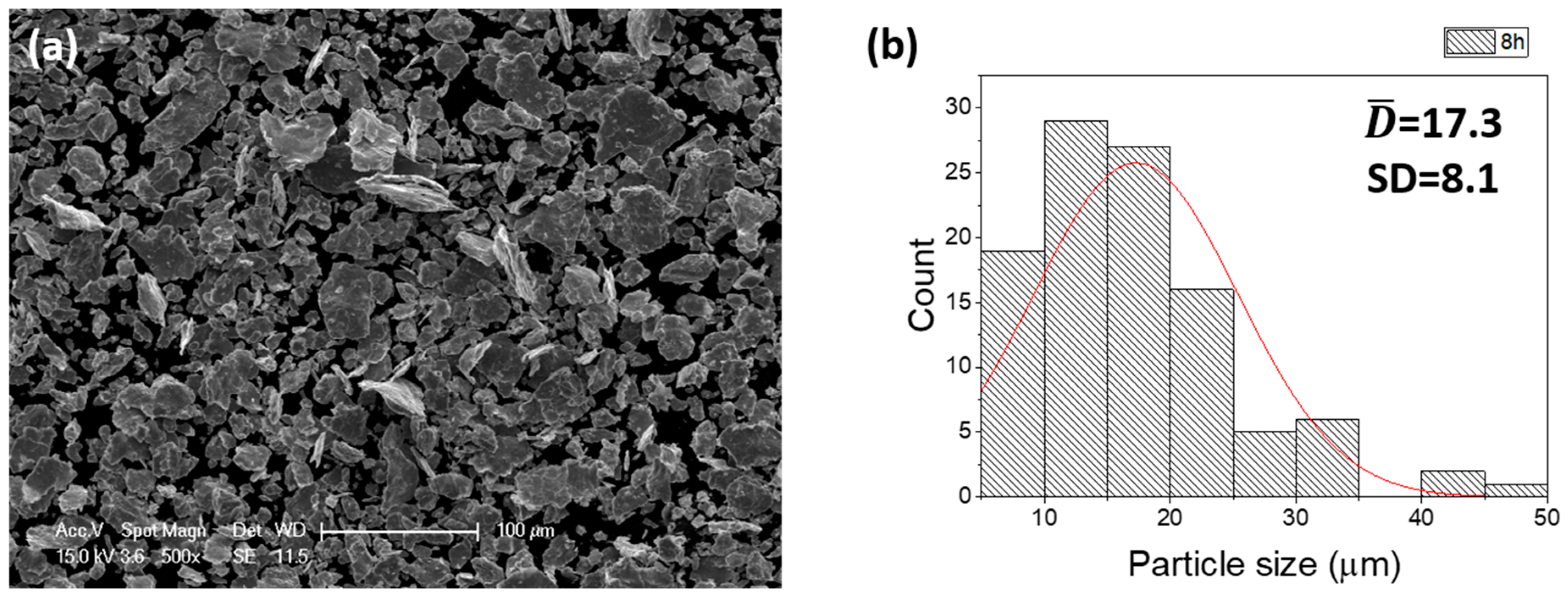

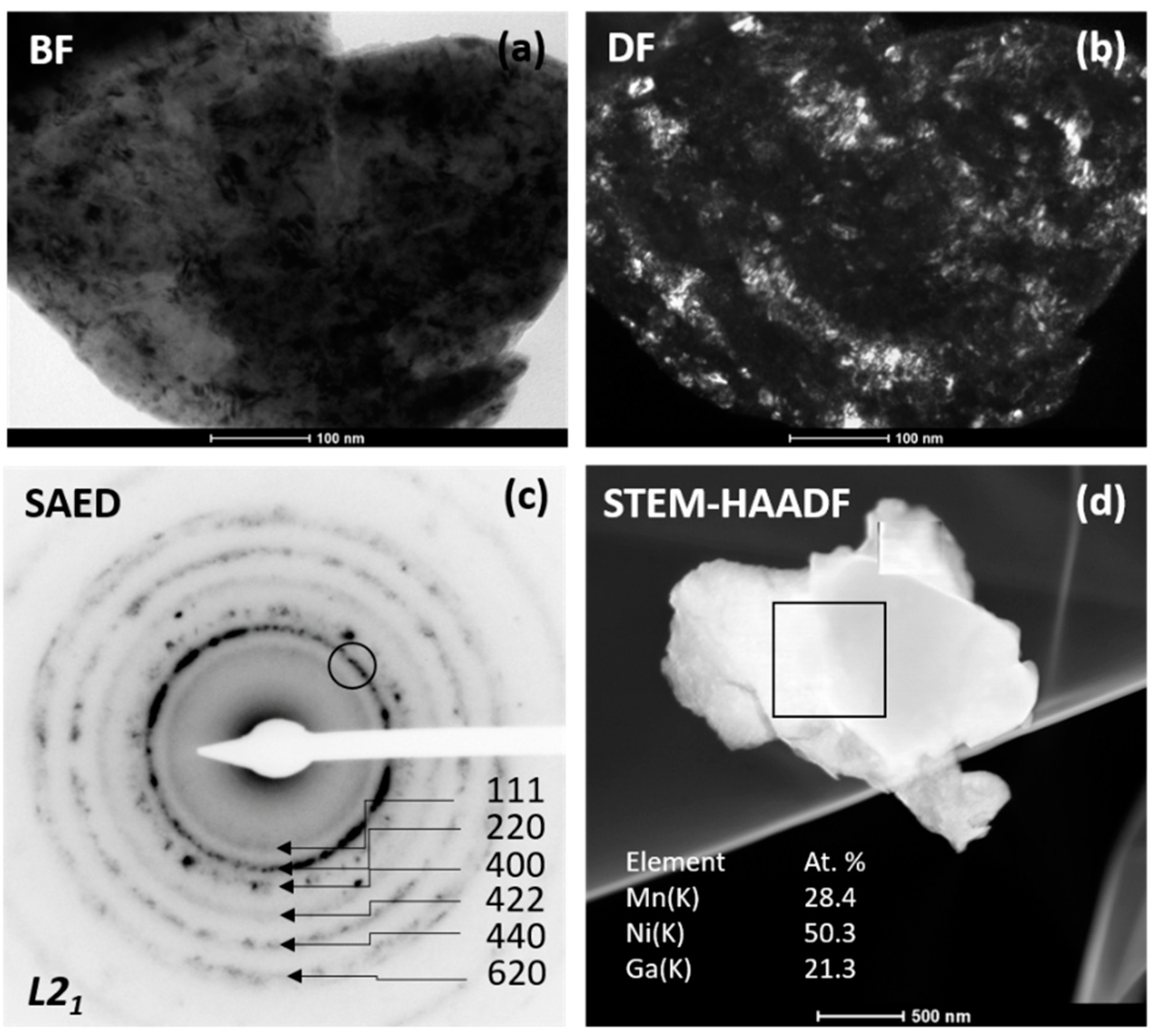
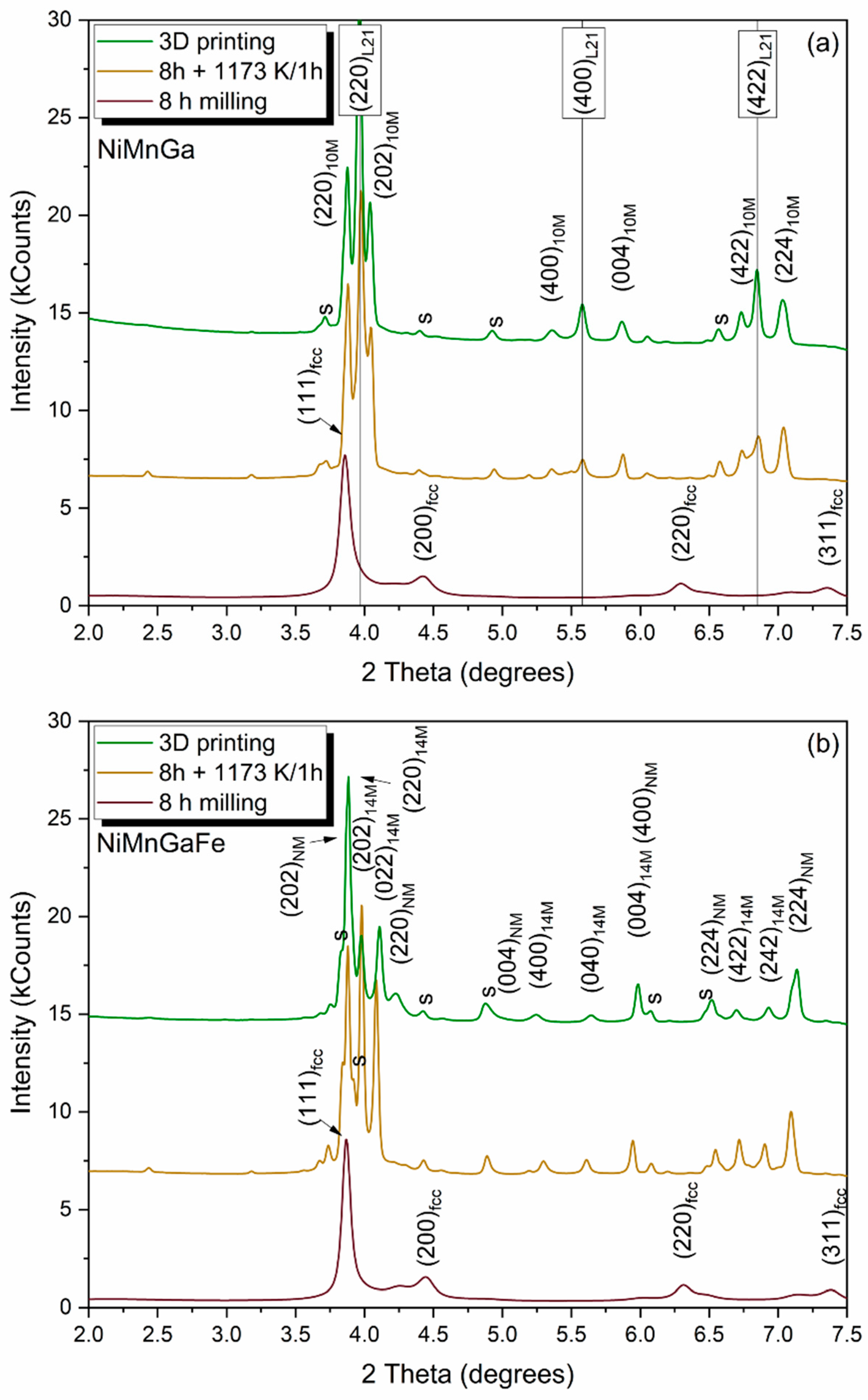
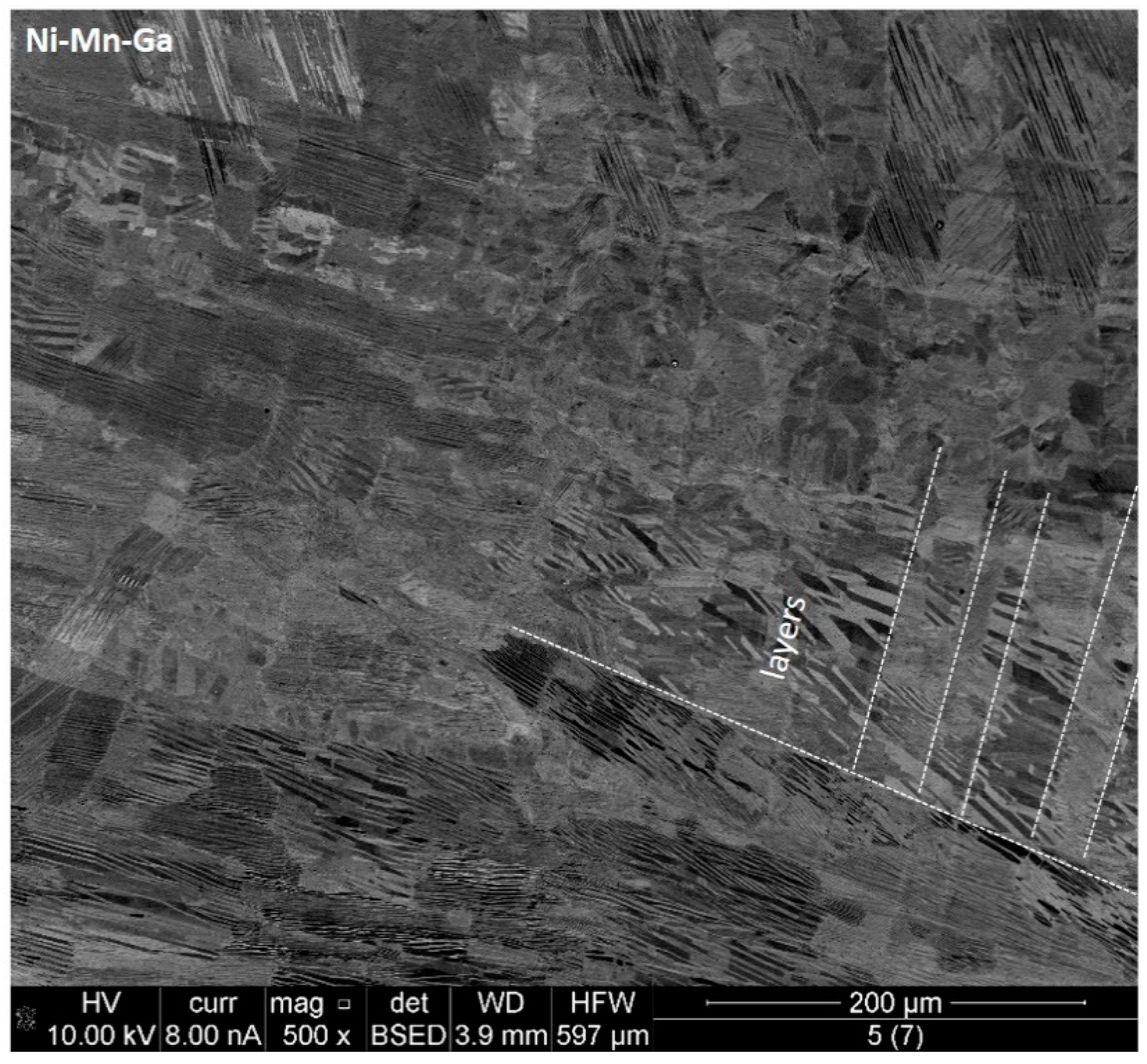

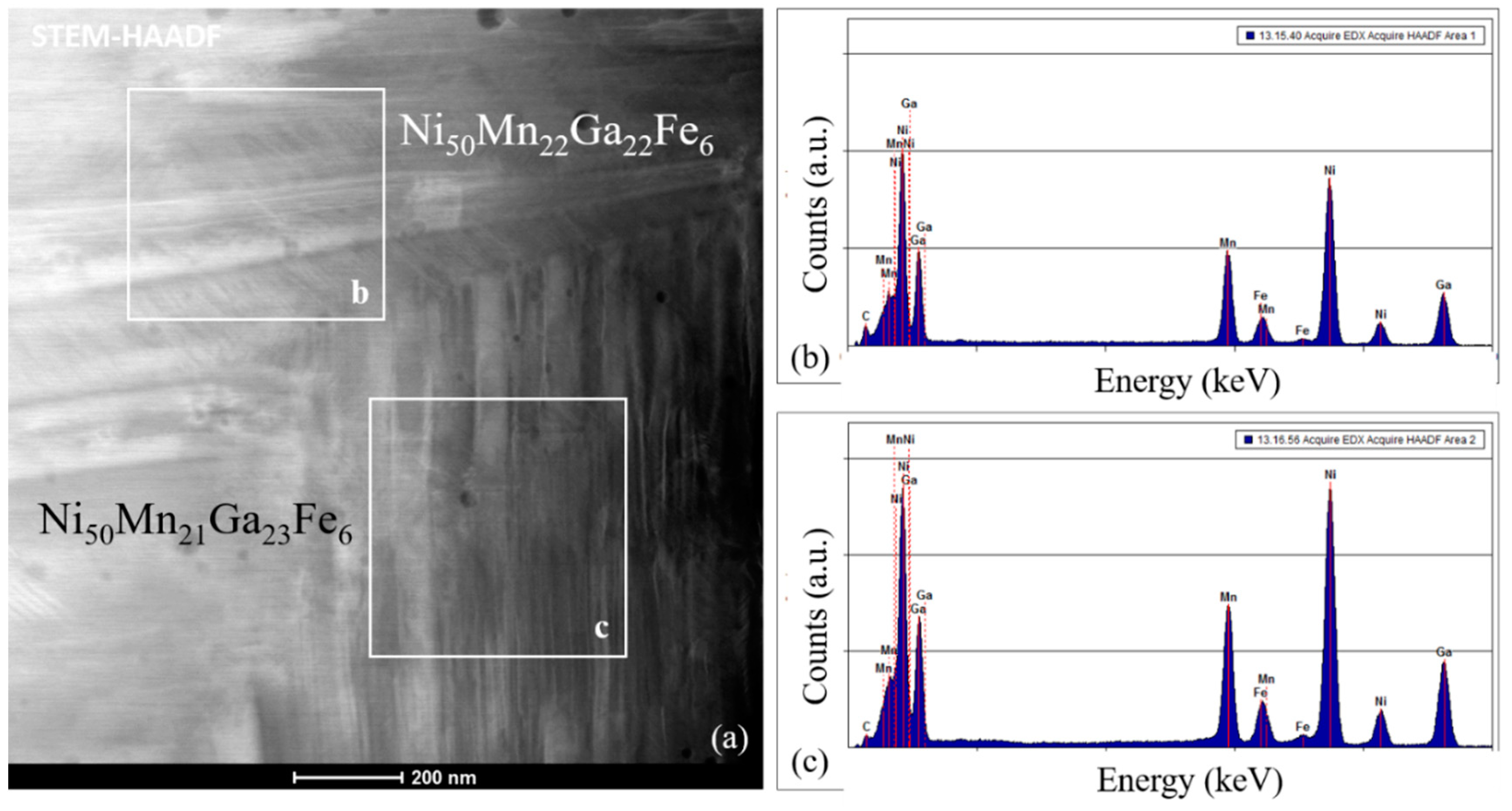




Publisher’s Note: MDPI stays neutral with regard to jurisdictional claims in published maps and institutional affiliations. |
© 2021 by the authors. Licensee MDPI, Basel, Switzerland. This article is an open access article distributed under the terms and conditions of the Creative Commons Attribution (CC BY) license (https://creativecommons.org/licenses/by/4.0/).
Share and Cite
Maziarz, W.; Czaja, P.; Chulist, R.; Wójcik, A.; Żrodowski, Ł.; Morończyk, B.; Wróblewski, R.; Kowalczyk, M. Microstructure and Magnetic Properties of Selected Laser Melted Ni-Mn-Ga and Ni-Mn-Ga-Fe Powders Derived from as Melt-Spun Ribbons Precursors. Metals 2021, 11, 903. https://doi.org/10.3390/met11060903
Maziarz W, Czaja P, Chulist R, Wójcik A, Żrodowski Ł, Morończyk B, Wróblewski R, Kowalczyk M. Microstructure and Magnetic Properties of Selected Laser Melted Ni-Mn-Ga and Ni-Mn-Ga-Fe Powders Derived from as Melt-Spun Ribbons Precursors. Metals. 2021; 11(6):903. https://doi.org/10.3390/met11060903
Chicago/Turabian StyleMaziarz, Wojciech, Paweł Czaja, Robert Chulist, Anna Wójcik, Łukasz Żrodowski, Bartosz Morończyk, Rafał Wróblewski, and Maciej Kowalczyk. 2021. "Microstructure and Magnetic Properties of Selected Laser Melted Ni-Mn-Ga and Ni-Mn-Ga-Fe Powders Derived from as Melt-Spun Ribbons Precursors" Metals 11, no. 6: 903. https://doi.org/10.3390/met11060903
APA StyleMaziarz, W., Czaja, P., Chulist, R., Wójcik, A., Żrodowski, Ł., Morończyk, B., Wróblewski, R., & Kowalczyk, M. (2021). Microstructure and Magnetic Properties of Selected Laser Melted Ni-Mn-Ga and Ni-Mn-Ga-Fe Powders Derived from as Melt-Spun Ribbons Precursors. Metals, 11(6), 903. https://doi.org/10.3390/met11060903







